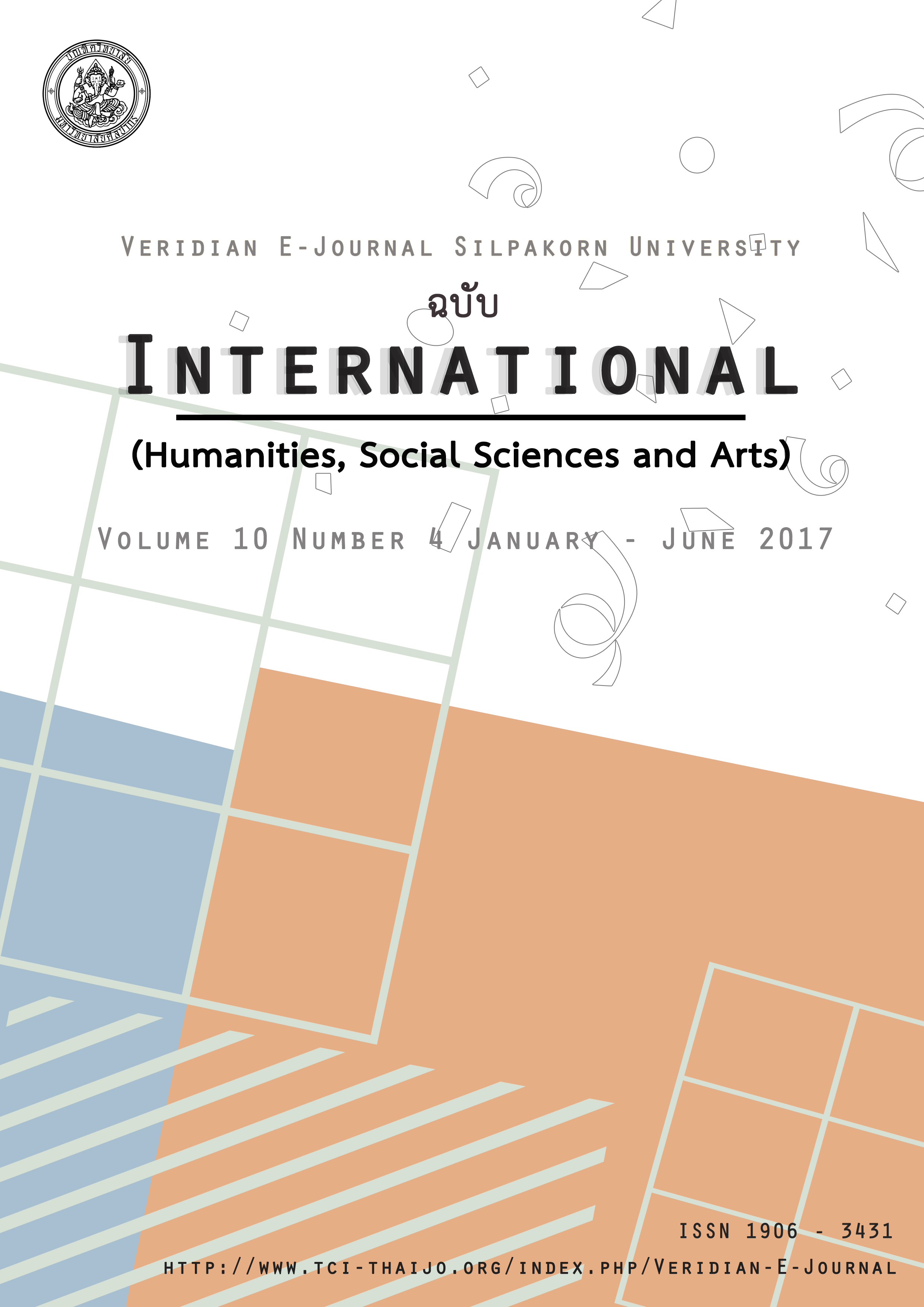An Analysis of Verbal Humor and Translation Techniques used in The American Comedy Film “TED”
Main Article Content
บทคัดย่อ
This study is an analysis of subtitle translation techniques of verbal humor employed in the American Comedy film TED. The purposes of this research were (1) to investigate the type of humor appearing in the movie; (2) to categorize the translation strategies in translating humorous aspects of Thai subtitles and (3) to examine how the humor type changes between source text and target subtitle text in the film. The 32 humorous extracts were collected from the original film script written by Seth Macfalane and the Thai subtitles translated by Suksit Seangprai. The scope of the analysis included the classifications of humor that were analyzed based on the humor types purposed by Long and Greasser (1988) and the translation techniques suggested by Nida (1964)’s translation approaches, Baker (1992)’s translation strategies, and Gottlieb (1992)’s subtitle translation.
The results reveal the 6 humor types appearing in the film. The highest frequently appearing in the film are hostile humor followed by nonsense humor, while scatological and sexual occurred respectively at the same frequency, followed by social satire and ethnic humor. In addition, the study found the 7 translation techniques were used for dealing with humorous expressions in this film; four of them were under Baker’s technique, one was based on Nida’s and Gottlieb’s technique and one method can be described as mixed. Specifically, the 7 techniques identified can be categorized as follows: (1) formal equivalence, (2) cultural substitution, (3) resignation,(4) mixed techniques, (5) paraphrase using related words, (6) paraphrase using unrelated words and (7) using neutral or less expressive words. Additionally, the researcher found that, in some cases, the meaning of the joke was literally changed, but the humor type contained in the original version was successfully conveyed to the Thai audience as the same type of humor. It can be concluded that the most important factor to consider when translating humor is retaining as much as possible of the original humor type.
งานวิจัยนี้มุ่งเน้นวิเคราะห์และจำแนกกลวิธีการแปลมุขตลกในบทบรรยายใต้ภาพที่ใช้ในภาพยนตร์ตลกอเมริกันเรื่อง “เท็ด หมีไม่แอ๊บแสบได้อีก” โดยมีวัตถุประสงค์เพื่อ (1) ระบุประเภทของมุขตลกที่เกิดขึ้นระหว่างบทสนทนาในภาพยนตร์เรื่องนี้ (2) จำแนกกลวิธีการแปลมุขตลกจากบทบรรยายใต้ภาพภาษาไทย และ (3) สำรวจการเปลี่ยนแปลงของประเภทของมุขตลกที่เกิดขึ้นในบทบรรยายใต้ภาพภาษาไทย ผู้วิจัยคัดเลือกตัวอย่างมุขตลกที่เกิดขึ้นทั้งหมด 32 ตัวอย่างจากบทภาพยนตร์ต้นฉบับซึ่งเขียนโดยเซ็ตห์ แม็คฟาเลน และบรรยายใต้ภาพภาษาไทยแปลโดยศักดิ์สิทธิ์ แสงพราย ขอบเขตของงานวิจัยครอบคลุมการระบุประเภทของมุขตลกโดยยึดตามทฤษฎีประเภทมุขตลกของลองและกรีเซอร์ (2531) และสำรวจกลวิธีการแปลภายใต้ทฤษฎีจุดประสงค์การแปลของไนดา (2507) กลยุทธิการแปลของเบเกอร์ (2535) และการแปลบทภาพยนตร์ของก๊อตลีบ (2535)
ผลการศึกษาครั้งนี้พบว่า มีมุขตลกทั้งหมด 6 ประเภทปรากฏในภาพยนตร์เรื่องนี้ ซึ่งมุขตลกที่พบมากที่สดคือมุขโจมตีผู้อื่น ตามลงมาด้วยมุขไร้สาระ มุขสกปรกและมุขลามกอนาจารเกิดขึ้นในสัดส่วนที่เท่ากัน ตามลำดับด้วยมุขเสียดสีสังคมและมุขล้อเลียนชาติพันธุ์ นอกจากนี้ ผลการวิจัยด้านการแปลพบว่าผู้แปลใช้กลวิธี 7 วิธีในการแปลมุขตลกในภาพยนตร์เรื่องนี้ ซึ่งแบ่งเป็นกลวิธีการแปลจากเบเกอร์ 4 วิธี จากไนด้าและก๊อตลีบอย่างละ 1 วิธี และการใช้หลายวิธีรวมกัน ทั้งนี้ กลวิธีที่พบทั้งหมด 7 วิธีจำแนกเป็นประเภทดังนี้ (1) การแปลตรงตัว (2) การแปลโดยแทนที่ทางวัฒนธรรมของภาษาแปล (3) การทิ้งความหมายเดิมทั้งหมด (4) การแปลโดยใช้หลายวิธีรวมกัน (5) การแปลแบบถอดความโดยใช้คำที่เกี่ยวข้องกับภาษาต้นฉบับ (6) การแปลแบบถอดความโดยใช้คำที่ไม่เกี่ยวข้องกับภาษาต้นฉบับ และ (7) การแปลโดยใช้คำที่แสดงความรู้สึกเป็นกลาง นอกจากนี้ ผลงานวิจัยยังพิสูจน์ให้เห็นว่า ในบางมุขตลกถึงแม้ว่าความหมายในฉบับแปลจะเปลี่ยนแปลงไป แต่ประเภทของมุขตลกที่ปรากฏในฉบับแปลนั้นยังคงสามารถถ่ายทอดมุขตลกประเภทเดิมของต้นฉบับสู่ผู้ชมชาวไทยไว้ได้อย่างสมบูรณ์ จึงสรุปได้ว่าปัจจัยที่สำคัญที่สุดในการในการแปลมุขตลกคือการรักษามุขตลกจากต้นฉบับให้มากที่สุด

